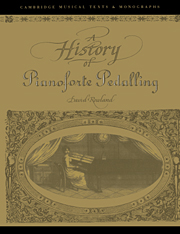Book contents
- Frontmatter
- Contents
- Acknowledgements
- List of abbreviations
- Introduction
- PART I The instruments
- PART II Pedalling and the early pianists
- 3 Documentary accounts of early pedalling
- 4 Early techniques of the pedals as described in tutors
- 5 Early pedal markings
- 6 Mozart and his contemporaries
- PART III Pedalling after c.1800
- APPENDIX: Chapters on pedalling from piano tutors
- Notes
- Select bibliography
- Index
3 - Documentary accounts of early pedalling
Published online by Cambridge University Press: 16 November 2009
- Frontmatter
- Contents
- Acknowledgements
- List of abbreviations
- Introduction
- PART I The instruments
- PART II Pedalling and the early pianists
- 3 Documentary accounts of early pedalling
- 4 Early techniques of the pedals as described in tutors
- 5 Early pedal markings
- 6 Mozart and his contemporaries
- PART III Pedalling after c.1800
- APPENDIX: Chapters on pedalling from piano tutors
- Notes
- Select bibliography
- Index
Summary
As far as the mutations of the piano are concerned, we cannot praise instrument makers sufficiently for their unstinting efforts in recent years to introduce a large number of mutations into the instrument. But they have seldom been used sufficiently by players and thus resemble a fine collection of books that no one ever reads.
(Milchmeyer 1797)Since the pedals remedy this defect … it would be quite wrong to renounce their use. We know that some people, by a blind attachment to the old rules, by a proper but badly understood affection, forbid their use …
(Adam 1804)To begin with this use of the registers was decried as charlatanism.
(Steibelt 1809)Several other fruitless essays were made to improve the construction of square pianos; and under the impossibility of attaining it, recourse was had to an augmentation of the number of pedals, the object of which was to modify the quality of the sounds. But these factitious means of producing effect were held but in little account by distinguished artists and true amateurs.
(Fétis 1827)These writers were unanimous in believing that stops, levers and pedals had been viewed with scepticism in the early stages of their history. Nevertheless, by the beginning of the nineteenth century such devices had been more or less universally accepted as an important element of piano technique. This change in attitudes occurred at different times in different places, and was the cause of a debate which can be observed in a variety of sources. It is this controversy and process of change which forms the study of the next three chapters.
- Type
- Chapter
- Information
- A History of Pianoforte Pedalling , pp. 29 - 41Publisher: Cambridge University PressPrint publication year: 1993



